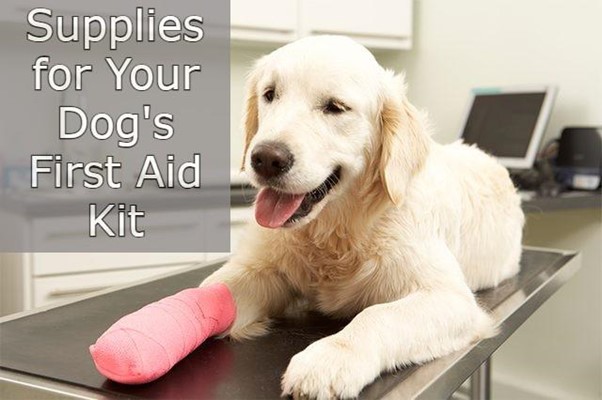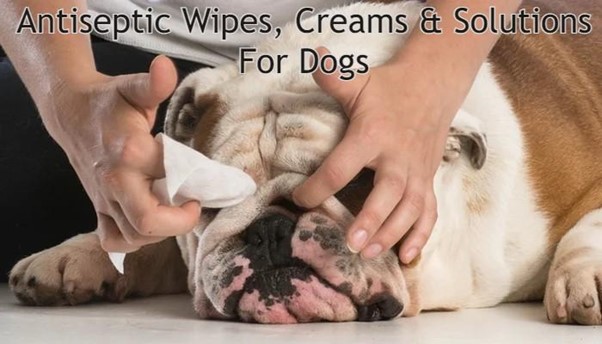Things to include in dog first aid kits for emergencies
- Last updated on April 7, 2023
- By: Caroline Stowe
As a pet parent, you know that your pet is just like a kid. Even if you have an elephant at your home as a pet, the same will consider you as a parent and yourself as a kid.
As human kids play and run so as the pets too, now when it comes to Dogs, the pups are very social and like to play and run here and there and around the places. Just like kids, now as your kids fall, get cuts, scrapes, and other injuries to the dogs too.
As you keep a First Aid kit for your loved ones means human kids, it is essential that you have the knowledge and resources to take care of your furry family member in case of an emergency as our furry naughty friends are prone to cuts, scrapes, and other injuries.
It is important to be prepared in case of an emergency with a first aid kit specifically designed for your pup. Having a dog first aid kit can be invaluable for treating common injuries or illnesses quickly and effectively, so it’s important to make sure you have one on hand.
Because accidents happen, and when they do, you want to be prepared. Whether it’s a minor cut or something more serious, having the right first aid supplies for your dog can make all the difference.
If you will have a proper kit for your pup it is important to be prepared and have the right supplies on hand for your dog should an emergency arise.
A well-stocked first aid kit is essential for any pet parent and can help you take care of minor injuries or illnesses until you can get to the vet. Let’s review what should be included in a comprehensive dog first aid kit.

Supplies and Equipment for Your Dog First Aid Kit
The most important aspect of any first aid kit is having the right supplies on hand. This includes things like bandages and gauze, antiseptic wipes, eye drops or ointment, tweezers, scissors, nail clippers, a rectal thermometer, cotton swabs, sterile saline solution, latex gloves or non-latex gloves (if your dog is allergic), an Elizabethan collar (aka “cone of shame”) if needed.
Be sure to also include a pet first aid book so that you can have easy access to step-by-step instructions for common medical emergencies.
Essential Supplies for Your Dog's First Aid Kit
When it comes to keeping your pup safe and healthy, you’ll want to make sure you have a first aid kit on hand. From bandages and gauze to tweezers and thermometers, there are many different items that can help you care for your pup in the event of an emergency.

Here’s a comprehensive guide for putting together the perfect pet first aid kit. A dog first aid kit should include supplies to help treat minor injuries, as well as items to help you respond in an emergency. The essential items for your kit should include:
Bandages and Dressings
Bandages and dressings are incredibly important components of medical care. They have a number of vital roles, from protecting wounds and preventing infection to providing support for injured or weakened limbs.
Bandages can also be used to help absorb excess fluids such as blood, pus, or discharge from the wound site of your pup.
The primary purpose of bandages and dressings is to protect the wound of the dog from external contaminants.
Dressings should be applied in such a way that they form a barrier between the wound and any bacteria, dirt, or debris that might cause further harm.
Bandages are also important for providing support to injured limbs, helping keep them in place, and reducing strain on healing joints and muscles.
Types of Bandage or Dressing
The type of bandage or dressing used will depend on the type and size of the wound, as well as other considerations such as how absorbent it needs to be.
There are a number of different types available such as gauze, adhesive tape, acetate cloth bandages, and hydrofiber dressings. Each has its own properties that make them suitable for different types of wound care in dogs.
Precaution
It is important to use the correct type of bandage or dressing for each wound of the dog, as the incorrect application can increase the risk of infection or further aggravate the injury.
Bandages and dressings should always be changed regularly to ensure that they remain effective and clean.
In addition, specialized medical attention may be required for more serious wounds. Proper wound care is essential in helping to speed the healing process and restore functionality to the afflicted area.
Antiseptic Wipes, Creams or Solutions, Hydrogen Peroxide
Antiseptics and Wound Care Products are essential for keeping wounds clean and reducing the risk of infection in your dogs.
Antiseptics are products that contain active ingredients such as alcohol, iodine, and hydrogen peroxide, which are used to destroy or inhibit the growth of microorganisms on skin or wound surfaces.
Common antiseptics include products such as alcohol wipes, antiseptic washes and solutions, antiseptic ointments, antibacterial soaps, and iodine solutions. These products help cleanse the wound area before dressing it to reduce contaminants that may cause infection.
Wound care products such as bandages, dressings, gauze pads, and wraps are also necessary for proper wound care. These products help keep the wound clean and protect it from further contamination while it heals.
Additionally, wound dressings can provide a moist environment that helps promote healing.
In addition to antiseptics and wound care products, certain topical medications may also be used on wounds to help reduce pain, inflammation, or infection.
Topical medications may include corticosteroids, antibiotics, antifungals, and antivirals. These medications can be applied directly to the wound or mixed with an antiseptic solution and then applied.

Your doctor will recommend which topical medication is best for your pup’s wound and provide instructions for proper application. It is important to remember that antiseptics and wound care products are only part of the treatment for any injury or wound.
Proper wound care can help prevent infection, reduce pain and discomfort, and promote quicker healing.
Common Antiseptic Creams For Dogs
The most common antiseptic creams for dogs are chlorhexidine and mupirocin. These topical products can be used to treat minor skin infections, hot spots, and abrasions.
They help to reduce bacteria in the affected area and contribute to the healing of the wound.
Additionally, many pet owners use over-the-counter antibiotic creams such as bacitracin or triple antibiotic ointment to treat minor wounds, cuts, and abrasions.
It is important to note that if the wound does not improve within a few days, then you should make an appointment with your veterinarian to determine if additional treatment is needed.
As always, it is best to consult with your vet before using any type of medication on your pet.
Some Helpful Tips
Finally, it is important to follow up regularly with your doctor or healthcare provider throughout the healing process.
They will be able to monitor the wound’s progress and make any necessary changes to your treatment plan if needed.
It is also important to practice good hygiene by washing your hands before and after tending to the wound and keeping it clean.
Following these tips can help ensure that your wound heals properly and quickly.
Medical Instruments
When it comes to assembling the medical instruments in the first aid kit for your dog, you should include all the items that depend on what type of care you will be able to provide and how prepared you need to be for any emergency that may arise.
Generally speaking, good medical instruments for dogs’ first aid kits include:
Tweezers
These can be used to remove ticks and splinters, as well as for general wound care.
Scissors
Scissors are great for trimming fur away from a wound and cutting bandages to the proper size.
Thermometer
A thermometer can be used to take your dog’s temperature in order to detect a fever.
Gloves
Gloves can help protect you from any diseases or parasites that may be present in the animal.
Towels
Towels are an essential item for cleaning up any messes or soaking up blood.
Eye Dropper And Oral Syringe
These are useful for administering liquid medications if needed.
Stethoscope
A stethoscope can help detect heart and lung problems.
Splints
Splints can be used to stabilize broken bones or injured limbs.
Emergency Blanket
An emergency blanket can be used to keep your dog warm in an emergency situation.
Flashlight
A flashlight is essential for seeing while examining your pet in the dark.
Muzzle
A muzzle can be used to help keep the animal from biting in an emergency situation.
By having these items on hand, you will be prepared to handle most minor injuries or illnesses that may arise.
It is also important to make sure all items in the first aid kit are up-to-date and replenished regularly, so you can be ready for any situation.
Additionally, it’s a good idea to familiarize yourself with basic pet first aid procedures such as bandaging wounds, controlling bleeding, and recognizing signs of shock.
Check out the video below to learn the basics.
Knowing how to respond to an emergency can help save your pet’s life.
Emergency Contact Information
It is important to have the contact information for your veterinarian and any emergency animal hospitals in case of an emergency.
Moreover, get the emergency contact information printed in your first aid kit as during an emergency you may not be in a state of mind to remember the contact numbers of your vet.
Note: It is always best to talk to a veterinarian before administering any kind of first aid, as they will be able to provide the most informed advice on how to best care for your pet.
Conclusion
Having a well-stocked first-aid kit ensures that you will have all the necessary supplies at hand should an emergency happen while out exploring with your pup!
Being prepared is key, so make sure you always bring along all the essentials like antibiotic ointment, tweezers, gauzes/bandages/tape, scissors and most importantly keep emergency phone numbers handy just in case!
After all, no one wants their furry friend getting hurt!
-
Author: Caroline Stowe
- Updated on April 7, 2023
Disclaimer: This article doesn’t intend to replace professional veterinary advice, nor should it be used as a substitute for veterinary services, diagnosis, or treatment. The content on this website, including information and opinions expressed herein, are intended for general informational purposes only. In case you have concerns or questions regarding your dog’s health and diet requirements, please consult your veterinarian before doing anything that might affect it.
DogPetGuide.com and the writer are not responsible or liable for any damage, liability, costs, or claims arising from any possible consequences of the reader’s action after reading this article.




